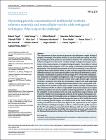| dc.contributor.author | Prina Mello, Adriele | |
| dc.date.accessioned | 2021-03-18T16:48:12Z | |
| dc.date.available | 2021-03-18T16:48:12Z | |
| dc.date.issued | 2021 | |
| dc.date.submitted | 2021 | en |
| dc.identifier.citation | Vogel, R. and Savage, J. and Muzard, J. and Camera, G.D. and Vella, G. and Law, A. and Marchioni, M. and Mehn, D. and Geiss, O. and Peacock, B. and Aubert, D. and Calzolai, L. and Caputo, F. and Prina-Mello, A., Measuring particle concentration of multimodal synthetic reference materials and extracellular vesicles with orthogonal techniques: Who is up to the challenge?, Journal of Extracellular Vesicles, 2021, e12052 | en |
| dc.identifier.other | Y | |
| dc.identifier.uri | http://hdl.handle.net/2262/95768 | |
| dc.description.abstract | The measurement of physicochemical properties of polydisperse complex biological samples, for example, extracellular vesicles, is critical to assess their quality, for example, resulting from their production and isolation methods. The community is gradually becoming aware of the need to combine multiple orthogonal techniques to perform a robust characterization of complex biological samples. Three pillars of critical quality attribute characterization of EVs are sizing, concentration measurement and phenotyping. The repeatable measurement of vesicle concentration is one of the key‐challenges that requires further efforts, in order to obtain comparable results by using different techniques and assure reproducibility. In this study, the performance of measuring the concentration of particles in the size range of 50–300 nm with complementary techniques is thoroughly investigated in a step‐by step approach of incremental complexity. The six applied techniques include multi‐angle dynamic light scattering (MADLS), asymmetric flow field flow fractionation coupled with multi‐angle light scattering (AF4‐MALS), centrifugal liquid sedimentation (CLS), nanoparticle tracking analysis (NTA), tunable resistive pulse sensing (TRPS), and high‐sensitivity nano flow cytometry (nFCM). To achieve comparability, monomodal samples and complex polystyrene mixtures were used as particles of metrological interest, in order to check the suitability of each technique in the size and concentration range of interest, and to develop reliable post‐processing data protocols for the analysis. Subsequent complexity was introduced by testing liposomes as validation of the developed approaches with a known sample of physicochemical properties closer to EVs. Finally, the vesicles in EV containing plasma samples were analysed with all the tested techniques. The results presented here aim to shed some light into the requirements for the complex characterization of biological samples, as this is a critical need for quality assurance by the EV and regulatory community. Such efforts go with the view to contribute to both, set‐up reproducible and reliable characterization protocols, and comply with the Minimal Information for Studies of Extracellular Vesicles (MISEV) requirements. | en |
| dc.language.iso | en | en |
| dc.relation.ispartofseries | Journal of Extracellular Vesicles; | |
| dc.relation.ispartofseries | 10; | |
| dc.relation.ispartofseries | 3; | |
| dc.rights | Y | en |
| dc.subject | Polystyrene | en |
| dc.subject | Extracellular vesicles | en |
| dc.subject | Particle size distribution | en |
| dc.subject | Liposomes | en |
| dc.subject | Multimodal samples | en |
| dc.subject | Nanomedicine | en |
| dc.subject | Orthogonal techniques | en |
| dc.subject | Particle concentration | en |
| dc.title | Measuring particle concentration of multimodal synthetic reference materials and extracellular vesicles with orthogonal techniques: Who is up to the challenge? | en |
| dc.type | Journal Article | en |
| dc.type.supercollection | scholarly_publications | en |
| dc.type.supercollection | refereed_publications | en |
| dc.identifier.peoplefinderurl | http://people.tcd.ie/prinamea | |
| dc.identifier.rssinternalid | 226108 | |
| dc.identifier.doi | http://dx.doi.org/10.1002/jev2.12052 | |
| dc.rights.ecaccessrights | openAccess | |
| dc.identifier.orcid_id | 0000-0002-4371-2214 | |




